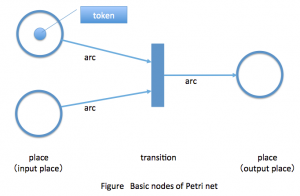A Petri net is one of several mathematical modeling language for the description of distributed systems, was proposed by C. A. Petri in 1962. *1
A Petri net is shown in the below figure. A Petri net consists of transitions represented by bars , places represented by circles and arcs represented by arrows and tokens represented by dots in places.
From the view of the transition, the place which holds arrow to the transition is named “input place” of the transition, and the place which holds arrow from the transition is named “output place”
The state transition of A Petri net occurs when all input places have tokens, the transition becomes fireable.
Once the transition fired, one token is removed from each input place respectively and one tokens is placed into each output place respectively.
Any distribution of tokens over the places will represent a configuration of the net called a marking.
One marking represents one state of the system. And the moving the tokens in the Petri net can be seen as flow of information in the system.
Comparing Petri net with state chart diagram, Petri net describes behaviors of whole discrete system and state chart describes behaviors of one object.
Because an actor can be considered as one object that send and receive messages to/from other actor, the state chart was chosen to model behaviors of an actor in DiD Risk Monitor.
*1: C.A. Petri, Kommunikation mit Automaten. Schriften des Rheinisch Westfälischen Institutes für Instrumentelle Mathematik an der Universität Bonn Nr. 2, 1962



